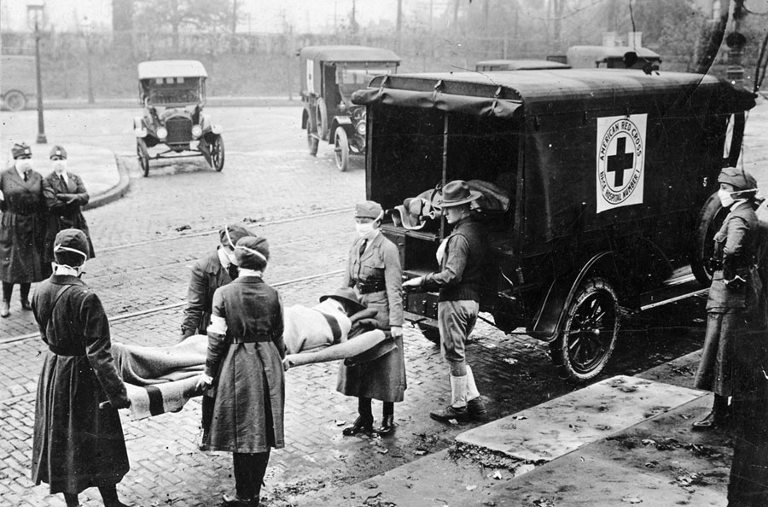The first truly worldwide pandemic may have been the Russian flu which traveled from eastern Russia to the rest of the world in 1889 and 1890. (I’m certain someone will dispute this claim, but it won’t affect my thesis.)
The death toll was estimated at around 360,000 which seems modest by our standards. The world population, however, was about 1.5 billion (circa 1900), so the presumed percentage of that population that died as a result of the Russian flu was about 0.02 percent. For comparison, the COVID-19 pandemic has so far killed 6.6 million people worldwide out of a population of approximately 8 billion. That’s 0.08 percent of the population, and the COVID-19 pandemic is by no means over.
It’s worth noting that some past pandemics have spanned decades (and even centuries if you count recurrences).
Perhaps the most profound changes in society resulted from the bubonic plague, also known as the Black Death, which occurred from 1347 to 1352. Some 25 to 30 million people are estimated to have died from the disease. Since world population is estimated to have been 443 million in 1340, this death toll would have been 6.8 percent of the population. But because the plague was centered in Europe and the Western Hemisphere was still unknown to Europeans, the effects were far more profound on that continent than the worldwide percentage of deaths would indicate.
The European continent was believed to have a population of 73.5 million in 1340. Assuming that the vast majority of deaths took place on that continent, that would put the percentage of the population killed at about 40 percent (assuming 30 million deaths).
While it was ongoing, the plague collapsed trade with other areas of the world and disrupted every aspect of life. Afterwards, European society was transformed. Most notably, labor was in short supply and so those at the bottom of the social scale were able to demand higher wages.
The feudal system was shattered. With so many people of working age dead and the death rate so uneven—some villages simply disappeared, others were less affected—the mobility of those still alive became a necessity. They could no longer be so tightly tied to the land. Rebellions against authorities became more common as those on the bottom felt relatively more confident in their newfound power. Some of this shift of power downward was the result of less competition for land and resources due to the dramatic drop in population in Europe.
Our contemporary society has seen nothing even remotely close to this to date. The so-called Spanish flu of 1918 killed between 20 and 50 million people worldwide. The world population was estimated to be 1.75 billion (as of 1910). The percentage of the world population that succumbed to this influenza pandemic was therefore between 1.14 and 2.86 percent.
The disruptions attending the seemingly minor COVID-19 pandemic (minor, at least by historical standards) have been profound. Companies and countries have become acutely aware of their vulnerability to globe-spanning supply chains and started to bring production closer to where it is sold. The vulnerability of those supply chains was made even clearer in the wake of the Russian-Ukraine war which resulted in severe trade sanctions on one of the world’s largest suppliers of raw commodities, Russia.
By the way, wars are particularly good at facilitating the spread of pandemics as was the case with World War I which continued until the end of 1918, the year of the Spanish flu pandemic.
Already the global trading system which existed before the COVID-19 pandemic has changed profoundly and continues to change. Restless and worried populations are vexing political leaders around the world as those populations seek political change in an effort to restore stability to their own lives.
It is disturbing to imagine what a new pandemic—even one no more severe than COVID—might mean for the economies and political and social systems of the world. It’s hard to see how governments, corporations and other organizations would severely restrict travel, worldwide shipping and social life in ways that would actually end the global spread of such an epidemic.
The global system of just-in-time delivery systems linked to worldwide supply chains and travel and accompanied by a growing middle class with more and more money to spend—these all grew up in an unusual era of geopolitical stability and global integration. Governments and businesses don’t want to give that up. But they are being forced to.
Stability has now given way to open hostilities and threats of hostilities from major powers such as Russia and China and responses from the United States and NATO countries. Dealing with a new pandemic under these conditions would likely put the wheels of change into overdrive with consequences that would almost certainly further undermine the global system that existed before COVID arrived.
Image: With masks over their faces, members of the American Red Cross remove a victim of the Spanish Flu from a house at Etzel and Page Avenues, St. Louis, Missouri. St. Louis Post Dispatch photo via [1] This media file is in the public domain in the United States. This applies to U.S. works where the copyright has expired, often because its first publication occurred prior to January 1, 1928, and if not then due to lack of notice or renewal. See this page for further explanation. https://commons.wikimedia.org/wiki/File:1918FluVictimsStLouis.jpg






